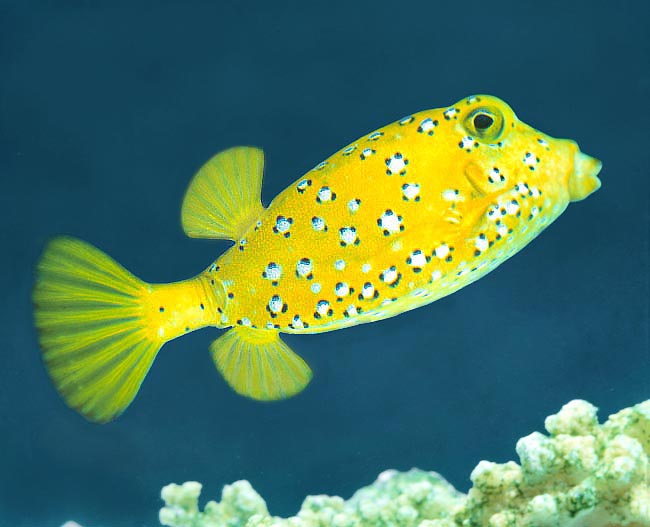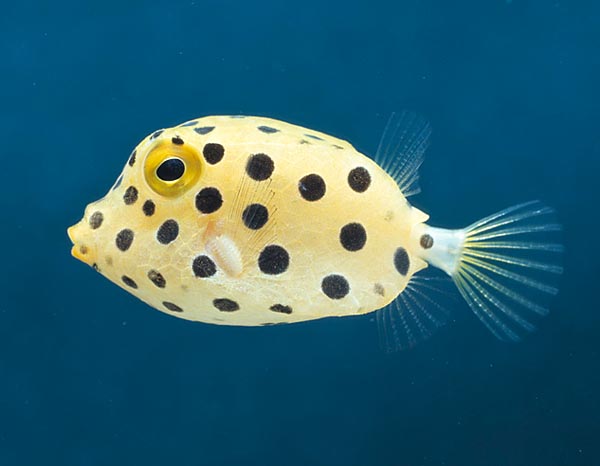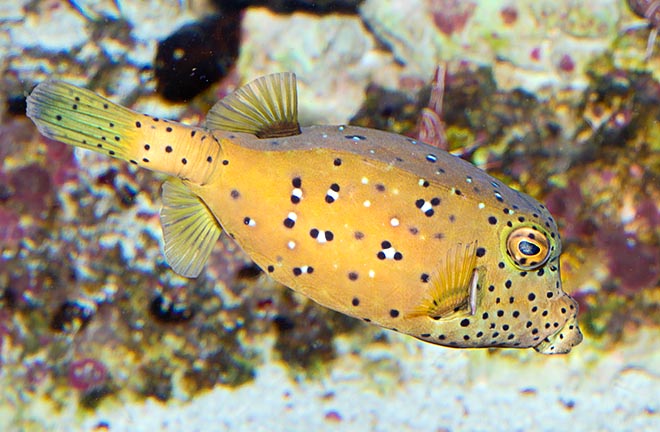Family : Ostraciidae

Text © Giuseppe Mazza

English translation by Mario Beltramini

Ostracion cubicus adult female. These fishes emit a toxin if stressed © Giuseppe Mazza
The name of the genus comes from the Greek “ostrakon” = shard, shell, with reference to the armour protecting it under the skin. The name of the species comes from the Latin “cubicus” = cubical, with reference to its shape.
Zoogeography
It has a vey vast diffusion in the Indian and the Pacific Oceans. As an indication, we find it from South Africa and Madagascar to the Red Sea and the Arabic Sea, the Seychelles, Maldives, India, Sri Lanka, Thailand, Malaysia, Australia, Indonesia, New Guinea, Micronesia, New Caledonia, Philippines, Taiwan and China up to southern Japan. Eastwards, it reaches the Tonga, Samoa, Hawaii and Tuamotu islands; southwards, Lord Howe.
Ecology-Habitat
It lives in the madreporic formations up to about 300 m of depth; even if, usually, it keeps in the first 50 m.

The young, shorter, have transparent fins and black spots of the ocular diameter © Giuseppe Mazza
Morpho-physiology
The yellow boxfish has a body with squared section and can reach the 45 cm of length. Like all boxfishes, it has under the skin, a carapace, formed by hexagonal plates, with openings for the eyes, the mouth and the fins with the anal hole. The ventral fins are absent, and the locomotion is entrusted to the undulations of the caudal and pectoral fins. The dorsal and the anal ones are used as helms, for slow but precise manoeuvrings.
By sure, it is not a good swimmer and therefore it sails usually close to the bottom, where the currents are weaker.
The young, proportionally shorter than the adults, have a yellow livery, more or less pale, with black spots of the ocular diameter. Then, while growing, some white spots appear, surrounded by small black ones.
The yellow colour gets deeper in the females, whilst the males assume dark hues, often brown-greyish, with a thick black spotting, whilst the white spots and the fin colour of blue.

A growing specimen. The big white spots are taking shape © Giuseppe Mazza
Ethology-Reproductive Biology
The Yellow boxfish is omnivorous. It nourishes of sea-weeds, foraminiferans, molluscs, sponges, ascidians, worms, crustaceans and small fishes.
It lives solitary or in small harems. This is usually one male with 2-4 females and the fecundated eggs are abandoned to the currents.
The populations may double in less than 15 months, and even if the young are often fished for the domestic aquaria, the vulnerability index of the species is very low: 23 per 100.
Synonyms
Ostracion argus Rüppell, 1828; Ostracion cubicum Linnaeus, 1758; Ostracion tuberculatus Linnaeus, 1758.
→ For general information about FISH please click here.
→ For general information about BONY FISH please click here
→ For general information about CARTILAGINOUS FISH please click here.
→ To appreciate the BIODIVERSITY of BONY FISH please click here.
→ To appreciate the BIODIVERSITY of CARTILAGINOUS FISH please click here.
